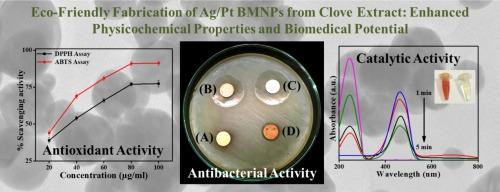Eco-friendly fabrication of Ag/Pt bimetallic nanoparticles from clove extract: Enhanced physicochemical properties and biomedical potential
IF 5.4
3区 化学
Q1 CHEMISTRY, INORGANIC & NUCLEAR
引用次数: 0
Abstract
This study presents a green and scalable synthesis of Ag/Pt bimetallic nanoparticles (BMNPs) using an eco-friendly extract from Syzygium aromaticum (clove buds) as a natural reducing and stabilizing agent. Unlike conventional chemical methods requiring toxic reagents, this approach enables the formation of highly stable and functional BMNPs under mild conditions. The synthesized Ag/Pt BMNPs exhibit superior catalytic efficiency in the reduction of p-nitrophenol (p-NP) to p-aminophenol (p-AP) (rate constant: 0.848 min−1) and the degradation of Methyl Orange (MO) dye (rate constant: 0.76 min−1), surpassing the performance of monometallic Ag and Pt nanoparticles. The synergistic alloying effect of Ag and Pt enhances electron transfer, leading to improved reaction kinetics and greater reusability over multiple catalytic cycles. Additionally, the adsorption of phytochemicals onto the NP surface significantly boosts antioxidant activity, with IC50 values of 32.6 µg/mL (DPPH assay) and 17.24 µg/mL (ABTS assay), while the enhanced antibacterial properties demonstrate a 14 mm inhibition zone against Escherichia coli. These findings establish Ag/Pt BMNPs as promising candidates for catalytic, environmental, and biomedical applications, offering a sustainable alternative to conventional nanoparticle synthesis.

从丁香提取物中环保制备银/铂双金属纳米颗粒:增强的物理化学性质和生物医学潜力
本研究提出了一种绿色、可扩展的银/铂双金属纳米颗粒(BMNPs)合成方法,该方法使用丁香芽的环保提取物作为天然还原剂和稳定剂。与需要有毒试剂的传统化学方法不同,这种方法可以在温和的条件下形成高度稳定和功能性的BMNPs。合成的Ag/Pt BMNPs在将对硝基苯酚(p-NP)还原为对氨基苯酚(p-AP)(速率常数为0.848 min−1)和降解甲基橙(MO)染料(速率常数为0.76 min−1)方面表现出优异的催化效率,超过了单金属Ag和Pt纳米颗粒的性能。Ag和Pt的协同合金化效应增强了电子转移,从而改善了反应动力学,提高了多次催化循环的可重用性。此外,植物化学物质在NP表面的吸附显著提高了抗氧化活性,其IC50值为32.6µg/mL (DPPH试验)和17.24µg/mL (ABTS试验),而增强的抗菌性能对大肠杆菌的抑制区为14 mm。这些发现确立了银/铂BMNPs作为催化、环境和生物医学应用的有前途的候选者,为传统的纳米颗粒合成提供了可持续的替代方案。
本文章由计算机程序翻译,如有差异,请以英文原文为准。
求助全文
约1分钟内获得全文
求助全文
来源期刊

Inorganic Chemistry Communications
化学-无机化学与核化学
CiteScore
5.50
自引率
7.90%
发文量
1013
审稿时长
53 days
期刊介绍:
Launched in January 1998, Inorganic Chemistry Communications is an international journal dedicated to the rapid publication of short communications in the major areas of inorganic, organometallic and supramolecular chemistry. Topics include synthetic and reaction chemistry, kinetics and mechanisms of reactions, bioinorganic chemistry, photochemistry and the use of metal and organometallic compounds in stoichiometric and catalytic synthesis or organic compounds.
 求助内容:
求助内容: 应助结果提醒方式:
应助结果提醒方式:


